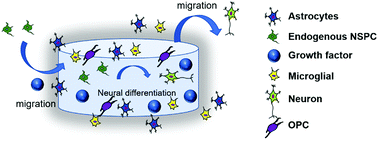Injectable hydrogels in stroke and spinal cord injury treatment: a review on hydrogel materials, cell–matrix interactions and glial involvement
Abstract
Central nervous system (CNS) pathologies, such as stroke and spinal cord injury, remain debilitating issues due to the inhibitory environment in the CNS. Many research works have focused on combinatorial therapeutic approaches, such as biomaterial scaffolding, cell transplantation and biomolecule delivery, in the hope of effectively improving functional recovery in vivo. Unfortunately, to date, there is still no effective treatment to regain mobility post-injury. In search of better therapeutic strategies, injectable hydrogels are becoming a popular treatment option for CNS diseases due to their tuneable mechanical properties and the minimally invasive nature of administration. Moreover, the ability to encapsulate exogenous cells and therapeutic molecules while providing an environment that is permissive to cells and promote cell survival incentivises the use of injectable hydrogels in CNS disease treatment. In this review, we will discuss the advances that have been achieved in the recent decade in injectable hydrogel systems for tissue regeneration after stroke and spinal cord injuries. In particular, we focus on the cellular response and tissue integration related to these hydrogel systems. We hope to provide useful insights on materials choices for future research work in injectable hydrogels for stroke and spinal cord regeneration.



 Please wait while we load your content...
Please wait while we load your content...